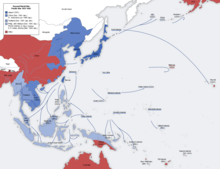
Back Южна доктрина Bulgarian Nanshin-ron Spanish نانشین-رون Persian Nanshin-ron French Nanshin-ron ID Nanshin-ron Italian 南進論 Japanese Nanshin-ron Portuguese Наньшин-рон Ukrainian 南進論 Chinese
This article includes a list of general references, but it lacks sufficient corresponding inline citations. (October 2010) |

Nanshin-ron (南進論, "Southern Expansion Doctrine" or "Southern Road") was a political doctrine in the Empire of Japan that stated that Southeast Asia and the Pacific Islands were Japan's sphere of interest and that their potential value to the Empire for economic and territorial expansion was greater than elsewhere.
The opposing political doctrine was Hokushin-ron (北進論, "Northern Expansion Doctrine"), largely supported by the Imperial Japanese Army, which stated the same but for Manchuria and Siberia. After military setbacks at Nomonhan, Mongolia; the start of the Second Sino-Japanese War tying down millions of Japanese troops in China; and negative Western attitudes towards Japanese expansionist tendencies, the Southern Expansion Doctrine became predominant. Its focus was to procure resources from European Southeast Asian colonies, eliminate supply routes to China, and neutralize the Allied military presence in the Pacific. The Army favored a "counterclockwise strike", while the Navy favored a "clockwise strike".[1]
- ^ "Centrifugal Offensive". The Pacific War Online Encyclopedia. Retrieved 21 December 2015.
© MMXXIII Rich X Search. We shall prevail. All rights reserved. Rich X Search